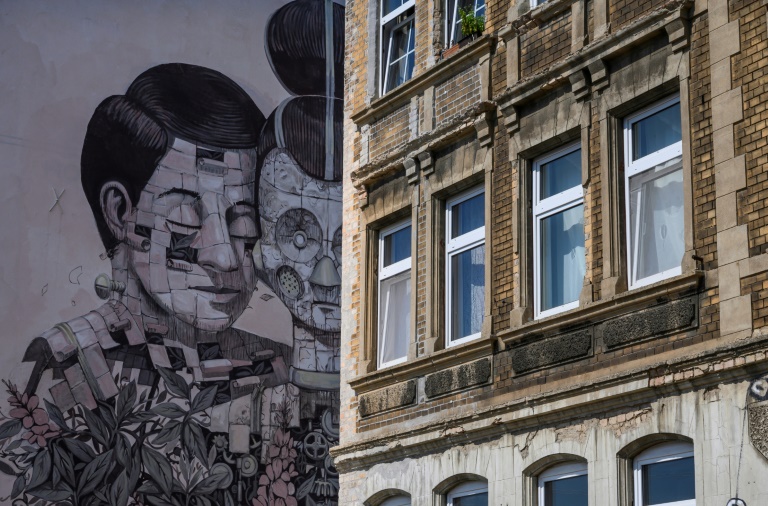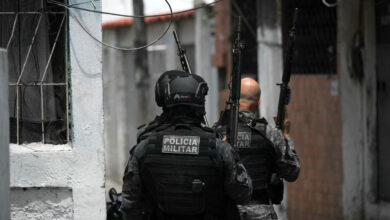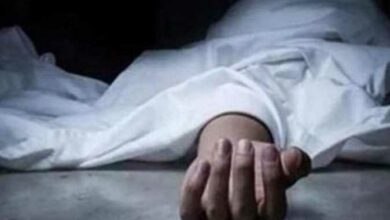
An enduring reminder of the communist era, the vast, concrete “Plattenbau” tower blocks that surround cities in eastern Germany are usually considered eyesores rather than works of art.
Yet, a new urban culture project in the city of Halle, 170 kilometres (around 100 miles) southwest of Berlin, hopes to promote social cohesion by transforming architectural sins into monumental masterpieces.
By brightening up the grey blocks made of prefabricated concrete slabs and often associated with poverty and tensions, artists aim to get people who don’t normally interact talking.
Adorning the side of one block, a three-dimensional mural in vivid colour depicts an astronaut descending from a satellite-like spaceship via a wooden ladder held by two men far below him.
In the background is a clear blue sky, giving the illusion that the walls have disappeared.
What could be a Pink Floyd album cover is in fact a work called “Balance Act” by the Freiraumgalerie artist and urbanist collective.
Still unfinished, it currently stretches around the outer walls of two buildings, bringing the otherwise dull facades to life.
“The artists chose this blue because they wanted to turn the hard and severe architecture of the Plattenbaus into something softer,” says collective member Philipp Kienast.
The seven-million-euro ($7.7-million) project, which once finished will cover 8,000 square metres (86,000 square feet) of wall space on four buildings, was commissioned by HWG, the housing association responsible for the blocks.
‘Everything is always changing’
When HWG began a full-scale refurbishment of the buildings in 2018, the idea was to create “something original with which the residents could identify”, says association managing director Juergen Marx.
They enlisted Freiraumgalerie, a collective known in Halle for reviving ageing buildings with vibrant graffiti, who actively involved locals in the “Balance Act” project.
“We invited residents to pose in different ways, photographed them, and then painted people in the same positions,” says Kienast.
Even if they did not paint exact likenesses, residents would be able to recognise themselves on the building, he added.
For resident Elfriede Schulz, a 79-year-old former teacher who has lived in the complex for over four decades, the project is a resounding success.
“People always say ‘oh you live in the Plattenbau’,” she says, miming an expression of disgust.
“I don’t like that, so I’m happy that these creations and colours can bring something good to the building.”
For HWG managing director Marx, the work conveys the message that “nothing stays as it is, everything is always changing”.
That is certainly true of this particular Plattenbau complex, which overlooks the prestigious Francke Foundations, an educational institution dating back to the 17th century.
Under communism, the modern apartments were prized among high-ranking party officials, earning them the nickname “bigwig blocks”.
Social unrest, crime
Nowadays, said Marx, the residents are more likely to belong to disadvantaged sectors of society. He estimates that around 40 percent of them are foreigners.
That is significant in a region which has seen a rapid rise in support for the far-right AfD party in recent years, and a city which is home to the German branch of the far-right Identitarian Movement.
In Halle, as in other east German cities, the Plattenbau complexes which surround the picturesque old town can be a backdrop for social unrest.
One of them, Neustadt, is notorious for its high crime rate and for being one of the poorest communities in Europe’s biggest economy.
Yet Marx hopes that art projects such as the one in Halle can help to strengthen community ties.
“When people know each other, everything becomes easier,” he says.
Freiraumgalerie’s Kienast agrees.
“In the places where we paint, people generally don’t have good social contacts with each other,” he said.
“When they look at our walls, even if they argue about it or don’t like it, it is a good opportunity for people to approach each other and talk about the art.
“That is something they would otherwise never have done.”
Photo caption: A new urban culture project in the German city of Halle, 170 kilometres (around 100 miles) southwest of Berlin, aims to promote social cohesion by transforming communist era tower blocks into monumental masterpieces




